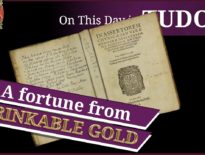On this day in Tudor history, 17th April 1595, or according to some sources 7th April, in the reign of Queen Elizabeth I, Jesuit Henry Walpole was hanged, drawn and quartered in the city of York. Walpole had been accused of three counts of treason.
Walpole felt that he'd been given a sign at the execution of Edmund Campion to carry on Campion's work, and, like Campion, his religious mission led him to his death.
Find out about the sign, what Walpole did, how he suffered awful torture, and about his sad end, in today's talk.
Also on this day in Tudor history, 17th April 1554, a court case didn’t quite go as Queen Mary I wanted and the jurors ended up in prison. Find out what happened in last year’s video:
Also on this day in history:
- 1534 - Sir Thomas More, Henry VIII's Lord Chancellor, was sent to the Tower of London after refusing to swear the “Oath of Succession”.
- 1554 – Thomas Wyatt the Younger's head was stolen in the rejoicing after Sir Nicholas Throckmorton's acquittal.
- 1554 – Birth of Stephen Gosson, Church of England clergyman, satirist and anti-theatrical polemicist. In 1579 he published his “Schoole of Abuse, containing a pleasant invective against Poets, Pipers, Plaiers, Jesters and such like Caterpillars of the Commonwealth”.
- 1568 – Birth of George Brooke, conspirator, son of William Brooke, 10th Baron Cobham and his wife Frances (née Newton). Brooke conspired with Sir Griffin Markham and William Watson to kidnap King James I and end the persecution of Catholics. The plot was called the Bye Plot, and never took place because the authorities found out about their plans. Brooke was arrested, tried at Winchester 15th November 1603 and executed on Winchester Castle green 5th December 1603.
Transcript:
On this day in Tudor history, 17th April 1595, or according to some sources 7th April, in the reign of Queen Elizabeth I, Jesuit Henry Walpole was hanged, drawn and quartered in the city of York. Walpole had been accused of treason on three counts: that he “had abjured the realm without licence; that he had received holy orders overseas; and that he had returned to England as a Jesuit priest to exercise his priestly functions”. Walpole was beatified in 1929 and canonised in 1970 by Pope Paul VI, so he is now St Henry Walpole.
The following is based on an article I wrote for the Tudor Society here a few years ago…
Henry Walpole was the eldest child of Christopher Walpole and Margery Warner, and he was baptised in October 1558 in Docking, Norfolk. Walpole was educated at Norwich Grammar School before studying philosophy and languages at Cambridge, at Peterhouse. He also studied at Gray's Inn.
On 1st December 1581, Walpole attended the execution of the Jesuit priest Edmund Campion and was splashed with the priest's blood. He saw this as a sign that he was to carry on Campion’s work and he wrote a poem “An Epitaph of the Life and Death of … Edmund Campion”, which was published anonymously and copies of it destroyed by Elizabeth I's government. The government suspected Walpole of being the poet and after the printer was punished by losing his ears, Walpole went into hiding at Anmer Hall in Norfolk, which belonged to his family. He then escaped to France, arriving at the English College in Rheims in July 1582. In 1583, he was accepted by the English College, Rome, and was ordained as a Jesuit priest in Paris on 17th December 1588.
Walpole served as a chaplain to the Spanish forces in the Netherlands under Colonel William Stanley and was arrested in Flushing after it fell to the English forces in the winter of 1589. He was released in January 1590 after one of his brothers paid a ransom. He then spent time on the Continent acting as a priest.
In November 1591, Elizabeth I issued an edict against Jesuit seminary priests, which was answered by Robert Persons with his “Responsio ad edictum”, published under the name of Philopater. Walpole was given the task of translating it into English as an attack not on the queen herself but on her advisor, William Cecil. In 1593, Walpole was sent on an English mission by Robert Persons, leaving from Dunkirk with his brother, Thomas. He landed at Flamborough Head, near Bridlington in Yorkshire, and he and his party were arrested on 7th December at Kilham and taken to York Castle where he admitted to being a Jesuit. In February 1594, Walpole was escorted to the Tower of London where he spent two months in solitary confinement and was tortured at least 14 times. In “Unpublished documents relating to the English martyrs” editor J H Pollen writes of how both his thumbs were lamed and that he was put into gauntlets. These iron gauntlets were constricting irons that were placed on the wrists and tightened by a screw, which was torture in itself, but then chains from a beam were attached to them and the victim was suspended from the chains without anything under their feet. The gauntlets would cut into the flesh and make the arms swell. He may also have been racked and he certainly lost proper use of his fingers. All of this torture was to try and get him to give information on seminaries in Spain and the names of their students. Although he did give some information, Antony Charles Ryan, his Oxford Dictionary of National Biographer biographer, notes that “One thing he did not do was to compromise anyone in England whose life would have been in peril as the result of revelations.”
In early 1595, Walpole was sent to York for trial and was found guilty of high treason. He was executed on 17th April 1595 and Ryan writes “When the day dawned, Walpole was dragged to the place of execution on a hurdle. Once again he testified his loyalty to the queen, so that some tried to persuade the magistrate to stop the execution. On the scaffold he was pushed and hanged before he could complete his prayers. He was immediately drawn and quartered.”



Leave a Reply